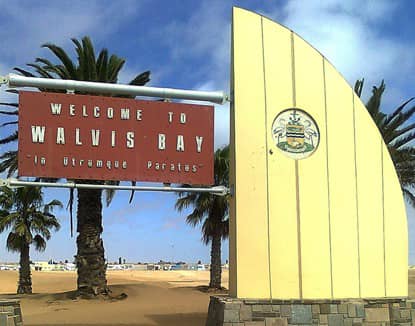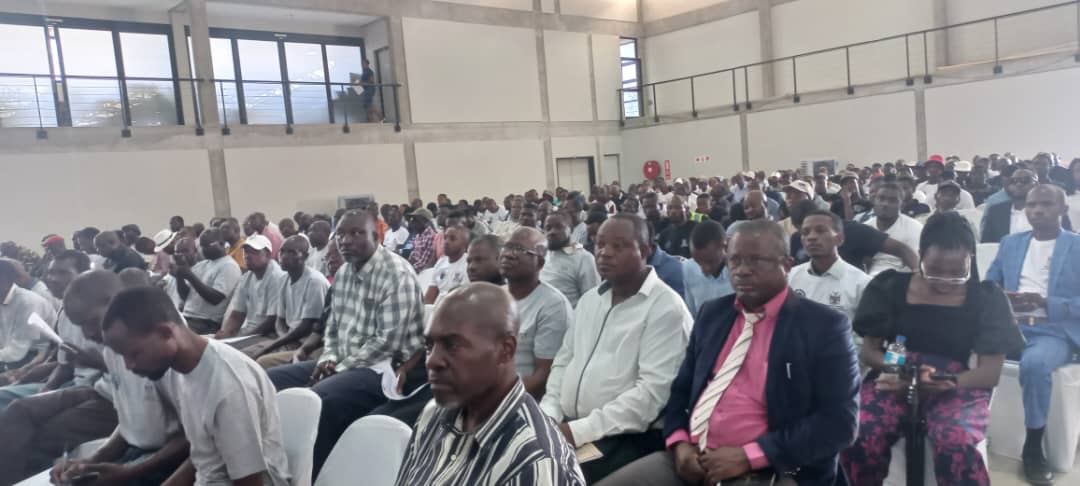He stands tall, his walking stick rooted in the all-seeing earth as he holds congress with his ancestors.
“Germans have hurt us to the bone,” he declares at the site of the mass graves of the former Swakopmund concentration camps which were brutally employed during the Herero and Namaqua genocide. “We keep losing court cases at high courts, Father. Help us, give blessings and lots of luck.”
The priest”;s voice is one of many sought out, recorded and presented in “;Ondjembo yo null vier- Fraitaxtses sores tsîn ge ra≠gâ”;, a multilayered and stirring artistic documentary by Berlin-based visual artist Ixmucané Aguilar, curated by Tristan Pranyko.
Beyond the priest who is archived as a single-channel video, akin to a second film installation that invites viewers to join a group of Herero woman in a desert march of mourning, Aguilar creates a circular stage for the descendants of the victims and survivors of the genocide.
Presented as a series of 130 portraits surrounding a three-dimensional sound field composed of Namibian voices recalling the horrors, brutality and escape routes endured by their relatives during German colonial rule, Aguilar”;s exhibition acts as a microphone for those whose stories have not been adequately documented and heard as the issue, reparations, lasting trauma and legacy of the genocide are debated and decided in the Namibian capital and in inaccessible foreign cities across the globe.
“I was interested in reaching the most remote areas of Namibia,” says Aguilar, who travelled to locations such as Gam, Otjimanangombe and Okakarara.
“I really wanted to go as far as possible and see how the colonial crimes and the after-effects of genocide are present in these areas.”
The result of Aguilar”;s conversations with these communities echoes in the NAGN”;s main gallery. An undulating and continuous stream of testimonies, lamentations, poetry by Nesindano Namises and Prince Kamaazengi Marenga, chanting and telling that engulfs and implores the viewer to bear witness and preserve memory. Some of it gruesome.
A woman raped repeatedly by German soldiers on Shark Island then tasked with scraping the dead head of her husband clean. Hands clasped over children”;s mouths as persecuted peoples hid or regrouped in mountainous caves. The remembrance of those who fled to Botswana and never came home until they were bone. The memory of mothers fleeing and shot. Grandmothers blindfolded, bound and murdered and of lost cattle, culture and land.
To Aguilar, these stories – gathered in the descendants”; houses, in their community halls and schools during long conversation sessions beginning in 2019 – are a way of accessing knowledge and experiences that have at times been denied, diminished or viewed through a colonial lens.
“The people in these areas are normally the people who are not heard. We could say they die silently with their memories, with their ruptures and they are never really in the centre of this important matter,” says Aguilar.
“This work is about the right to defend memory, collective memory, but it”;s not only about the past. It”;s also about claiming a future.”
Extensively researched and inclusive of such items as an archival copy of German military commander Lothar von Trotha”;s declaration to “the rebellious Nama tribes” offering 5 000 German marks for Hendrik Witbooi dead or alive as well as the Namaqua chief”;s response, Aguilar”;s exhibition is meticulously curated, down to its title: “;Ondjembo yo null vier- Fraitaxtses sores tsîn ge ra≠gâ”; (“;The Gun of Null Vier / Even Friday”;s Sun Sets”;).
“The titles are based on my research, the narratives and conversations I documented in the Nama and Herero communities,” says Aguilar.
“The Nama title is a phrase in southern Namibia, specifically from the clan of Cornelius Frederiks, and it refers to a specific Friday. This Friday the men of the village were lured into the church to pray but they were surrounded by German soldiers of the Schutztruppe and taken hostage within the holy walls,” Aguilar says.
“Even this day took an end with the setting sun.”
VOICES
In Otjiherero, the title refers to a tradition of naming each year after a significant event. “The year 1904 was named in different ways. For example, “;Ovita Vyo Va Ndoitji N”;OvaHerero”; (“;The war of the Germans and the Ovaherero”;) and also as “;Ondjembo yo Null Vier”;,” says Aguilar.
“They left the “;Null Vier”; in German, which seems to me to be a call to name the year with the language of the intruder, as putting a spell on the invader.”
Aguilar, who is of dual Afro-Caribbean and Guatemalan heritage, knows something of invaders.
“The reality of Guatemala is that we also went through a period of colonisation, of dictatorship, military occupation and genocide,” says Aguilar.
“I grew up in political exile in Mexico, far away from my country, and I think that has definitely left an indelible mark on me and influences my artistic practice. I often engage with communities affected by political and historical layers. I engage in conversations and I go through an intensive research process,” she says.
“As an artist, I”;m not working on work that is autobiographical. I”;m more interested in global issues so that”;s why I came to Namibia during my studies and I started this communication.”
While Aguilar may seem far removed from the Herero and Namaqua genocide, as a visual artist, photographer and a documentarian, she takes pains to let the descendants speak for themselves.
Her portraits of OvaHerero and Nama women, men, children and elders are direct, unadorned and solemn, set in a blank “non-place” that demands focus and a meeting of the eye.
The voices that affect, dip and swell in the main gallery are the people”;s own and a large, emblematic sand print in collaboration with Timo Moors depicts the pivotal Namib Desert, which has protected but also conceals the land”;s murdered people.
“The work is about these voices which insist on defending memory in the face of social injustice. So even though it belongs to Namibia, my attempt is to create a broader understanding of human reality,” says Aguilar, who will also be publishing a book of this work.
“It”;s also about us, as human beings, living within environments that in one way or another have embedded codes of injustices,” she says.
“And then there is this need for rebellion against oppression, against colonial mentalities that are still present and against foreign occupation. My longing is to create spaces which invite people of different backgrounds to engage with this complexity of our reality,” Aguilar says.
“Beyond the portraits stands the human … and beyond all the words is the wisdom.”
Stay informed with The Namibian – your source for credible journalism. Get in-depth reporting and opinions for
only N$85 a month. Invest in journalism, invest in democracy –
Subscribe Now!






